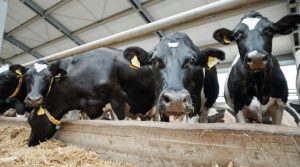
In this article, Dr Richard Kirkland, ruminant nutritionist for Volac Wilmar Feed Ingredients, discusses dietary changes to mitigate heat stress losses in dairy cows.
For dairy producers going into hotter months, having a plan in place to adjust rations as temperatures spike can offset production losses associated with heat stress.
When temperatures reach 25°C, cows can really start to be impacted by heat and reduce feed intake.
Intake continues to decline as temperatures increase. Research data demonstrates a 20-40% decrease in dry matter (DM) intake when temperatures reach 40°C.
These effects become more pronounced where humidity is also an issue.
The temperature-humidity index is often used to indicate degree of stress on dairy cattle. Higher humidity will see more-severe heat stress issues at lower temperatures.
A reduction in DM intake results in a reduction in energy intake, resulting in less energy available for production.
This is further compounded by an increase in maintenance requirements of the cow, increasing upwards of 25% as breathing rate and panting are elevated to help lose heat for body temperature regulation, therefore, reducing energy availability.
If not managed, cows will quickly fall into an energy deficit. As a result, other functions, including fertility and milk production are significantly reduced.
Research studies have reported conception rates falling as low as 10% during the hottest months of the year and milk yield falling by 35%.
Increasing energy density
When it comes to dietary management to mitigate the effects of heat stress, delivering energy density via a rumen-protected fat should be a key priority.
Simply swapping lower-energy forage for highly-fermentable cereals will effectively increase the energy density of the ration on paper.
However, these starchy supplements will lead to increased acid in the rumen. It is already under pressure to function adequately and effectively during heat stress conditions.
This can lead to acidosis, which knock-on effects include lameness and reduced milk fat production.
Supplementing diets with energy-dense nutrients like rumen-protected fats is the most effective way to help meet energy requirements while not adding to the acid load in the rumen.
Compared to cereals, a proven calcium salt fat supplement like Megalac has around 2.5-times the concentration of energy. This makes it a great ingredient to safely increase the energy supplied in every bite of feed.
Fat is also considered a ‘cool’ ingredient, generating considerably less heat during digestion and metabolism compared to other feeds.
This is something producers need to be aware of when choosing other feed ingredients.
Digestion of feed requires energy and the process also generates heat internally.
Offer good quality, highly-digestible forage to the highest yielding cows under the most stress. Digestible fibre sources will help maintain production without increasing rumen acid load.
Avoid poor quality forage as it requires a lot more work by the animal to chew and digest – generating greater internal heat production.
However, producers need to consider the most appropriate type of fat supplement based on the fatty acid profile of the supplement to best meet farm targets, rather than just considering the direct energy element.
Selecting fatty acids to support milk contracts
Aside from being an energy-dense feed ingredient, the fatty acid make-up of the fat will determine which aspect of performance can be most influenced.
For example, cows in early lactation and approaching their next breeding window would benefit from a traditional calcium salt supplement that offers a source of rumen-protected oleic acid (C18:1).
This helps improve body condition, development of eggs and embryos, and total diet fat digestibility.
On the other hand, the high-C16:0 (palmitic acid) supplements are effective at stimulating milk fat production and may be of interest under heat stress conditions where milk fat often declines.
However, palmitic acid can cause partitioning of nutrients away from body fat resulting in lower body condition which may not be desirable.
By understanding the impact these key fatty acids have on specific performance areas, farmers can better target overall herd productivity while also meeting cow energy demands during hotter months.

























